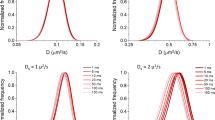Abstract
Analysis of atomic forces in molecular scale including the reciprocal internal force directions, quantity, and Young’s modulus, and more detailed analysis via diagrams, is one of the most current research topics. This research aims to analyze the bilateral forces applied between a nano-actuator and a cargo from a new perspective. While virtual springs have been used as a tool to convey forces in the previous steered molecular dynamics simulations, this study uses the spring as a sensor for measuring the internal forces. This study introduces atomic sensing via the steered molecular dynamics method. Following the previous studies, the protein employed in this study is the mutated Archetype Prefoldin being used to control the pathogenic cargo beta-amyloid (Alzheimer’s). The powerful Gromacs software carries out the simulations for the calculation of the total force and force for each branch. The simulation results illustrate the total force between the cargo and nano-actuator is ~ 2.8 nN, while each branch needs a force of ~ 1.2–1.5 nN to release the cargo. The results demonstrate the validity of the method and applicability of the virtual sensor for assessing the microscopic forces. This investigation is a pioneer study for the advent of the sensor as an assessment tool for the mechanical analysis and precise atomic force studies.









Similar content being viewed by others
References
Falotico, R., Kopia, G. A., & Llanos, G. H. (2014). Inventors; Wyeth LLC, assignee. Drug/drug delivery systems for the prevention and treatment of vascular disease. United States patent application US, 14(/160), 775.
Dubey, A., Sharma, G., Mavroidis, C., Tomassone, M. S., Nikitczuk, K., & Yarmush, M. L. (2004). Computational studies of viral protein nano-actuators. Journal of Computational and Theoretical Nanoscience, 1(1), 18–28.
Ghaffari, A., Shokuhfar, A., & Ghasemi, R. H. (2011). Prefoldin: a nano actuator for carrying the various size nano drugs. Journal of Computational and Theoretical Nanoscience, 8(10), 2078–2086.
Shokuhfar, A., Ghaffari, A., & Ghasemi, R. H. (2012). Cavity control of Prefoldin nano actuator (PNA) by temperature and pH. Nano-Micro Letters, 4(2), 110–117.
Ghaffari, A., Shokuhfar, A., & Ghasemi, R. H. (2012). Capturing and releasing a nano cargo by Prefoldin nano actuator. Sensors and Actuators B: Chemical, 171–172, 1199–1206.
Askarian, M., Moavenian, M., & Ghasemi, R. H. (2013). Prefoldin β1: a new bio-nanorobots component, advanced science. Engineering and Medicine, 5(9), 895–904.
Keramati, M., & Ghasemi, R. H. (2017). A molecular dynamics investigation of the effects of mutation on Prefoldin nano actuator in inhibiting amyloid β42-dimer. Sensors and Actuators B: Chemical, 248, 536–544.
Sharma, G., Rege, K., Budil, D. E., Yarmush, M. L., & Mavroidis, C. (2008). Reversible pH-controlled DNA-binding peptide nanotweezers: an in-silico study. International Journal of Nanomedicine, 3(4), 505–521.
Knowles, T. P., Fitzpatrick, A. W., Meehan, S., Mott, H. R., Vendruscolo, M., Dobson, C. M., & Welland, M. E. (2007). Role of intermolecular forces in defining material properties of protein nanofibrils. Science, 318(5858), 1900–1903.
Israelachvili, J. N. (2011). Intermolecular and surface forces. Academic press.
Lorenzo, A. C., & Caffarena, E. R. (2005). Elastic properties, Young’s modulus determination and structural stability of the tropocollagen molecule: a computational study by steered molecular dynamics. Journal of Biomechanics, 38(7), 1527–1533.
Gautieri, A., Vesentini, S., Montevecchi, F. M., & Redaelli, A. (2008). Mechanical properties of physiological and pathological models of collagen peptides investigated via steered molecular dynamics simulations. Journal of Biomechanics, 41(14), 3073–3077.
Abbasi, A. A., Ahmadian, M. T., & Taheri, R. A. (2013). Manipulation of biological cells using a nano-micronewton force controlled gripper. Transaction on Control and Mechanical Systems, 2, 97–104.
Izrailev, S., Stepaniants, S., Isralewitz, B., Kosztin, D., Lu, H., Molnar, F., Wriggers, W., & Schulten, K. (1999). Steered molecular dynamics. In Computational molecular dynamics: challenges, methods, ideas (pp. 39–65). Berlin: Springer.
Abraham, M. J., van der Spoel, D., Lindahl, E., Hess, B., & the G, development team. (2014). Gromacs user manual version 5.0, www.Gromacs.org.
Author information
Authors and Affiliations
Contributions
All authors have participated in (a) conception and design, or analysis and interpretation of the data; (b) drafting the article or revising it critically for important intellectual content; and (c) approval of the final version.
Corresponding author
Ethics declarations
This manuscript has not been submitted to, nor is under review at, another journal or other publishing venues.
Conflict of Interest
The authors declare that they have no conflict of interest.
Additional information
Publisher’s Note
Springer Nature remains neutral with regard to jurisdictional claims in published maps and institutional affiliations.
Rights and permissions
About this article
Cite this article
Salehi Mojarrad, M.H., Goodarzi, V. & Taheri, R.A. Force Sensing in Nanoscale: Integration of Virtual Spring for Sensing the Interactions of β-Amyloid Grabbed by Prefoldin. Appl Biochem Biotechnol 188, 1108–1116 (2019). https://doi.org/10.1007/s12010-019-02975-6
Received:
Accepted:
Published:
Issue Date:
DOI: https://doi.org/10.1007/s12010-019-02975-6




